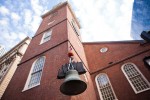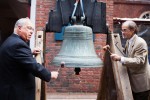 The 210-year-old bronze bell cast by Revere & Sons purchased this summer from the First Baptist Church of Westborough was raised into the steeple of Boston’s Old South Meeting House on Sunday.
The 210-year-old bronze bell cast by Revere & Sons purchased this summer from the First Baptist Church of Westborough was raised into the steeple of Boston’s Old South Meeting House on Sunday.
Mayor Thomas Menino struck the bell with a gavel, then before a cheering crowd, a crane slowly hoisted the 876-pound bell nearly 200 feet to a waiting inanimate iron rods extending from the bell tower. The rods were then drawn into the steeple sliding the bell into the clock tower. As soon the clock mechanism was stopped momentarily so it could be connected to the bell ringing mechanism, handbell choir Back Bay Ringers played “The Battle Hymn of the Republic” and church bells all over Boston rang in unison welcoming the oldest Paul Revere bell on the Freedom Trail. (Not even the bell at the Paul Revere House is older; it was built in 1804.)
 Other than the ceremonial gaveling, however, the Revere bell has not been rung yet. The striking mechanism needs a couple of weeks more work before the bell can peal once again. The bell itself, despite its age and an incident in 1938 when it was torn out of the Westborough steeple into a cemetery by a hurricane, is in excellent condition. Its wooden elements — the yoke and frame on which it rests and the bell wheel — needed far more attention than the bell itself. The yoke and frame are original and so were carefully restored.
Other than the ceremonial gaveling, however, the Revere bell has not been rung yet. The striking mechanism needs a couple of weeks more work before the bell can peal once again. The bell itself, despite its age and an incident in 1938 when it was torn out of the Westborough steeple into a cemetery by a hurricane, is in excellent condition. Its wooden elements — the yoke and frame on which it rests and the bell wheel — needed far more attention than the bell itself. The yoke and frame are original and so were carefully restored.
The bell wheel had been hastily constructed after that 1938 hurricane. It was neither functional nor historical, so the Old South Meeting House enlisted the aid of Jeff D. Makholm, an economist who in his spare time loves building boats and recreating historical carpentry. Makholm had built a bell wheel for the Old South Church, so he had specific relevant experience. He used 19th century architectural drawings to recreate the wheel as it would have been out of quarter-sawn white oak with gold leaf accents.
The Old South Meeting House, famous as the place where the Boston Tea Party was launched in 1773, has not had a bell in the tower since 1876. Officials weren’t even sure the bell would ring properly given how much vertical real estate has grown around the small colonial building since then. Architect and historical preservationist Wendall Kalsow enlisted the aid of professional acoustician Lincoln B. Berry to determine whether the bell could actually be heard in the downtown Boston of today.
As good luck would have it, downtown Boston of today has even better bell acoustics than it had in 1801 when the bell was first cast.
Surrounding the steeple are tall buildings with reflective windows that cause the peal of a bell to bounce back toward its source. Instead of hearing one ring coming from the steeple, bystanders will find themselves enveloped by a cascade of bells coming from many directions.
A downtown pedestrian in 2011 would probably have a better listening experience than a colonial Bostonian as tones of C-sharp, E, and A tumble down the walls of neighboring skyscrapers.
“It’s kind of like a concert hall,” Berry said. “The tower’s proximity to various buildings is going to produce a nice ripple of reflection, and it will add some grandeur to the overall character of the sound.”
I can’t wait to hear it. Until then, here’s some video of the bell’s dramatic slow lift to the steeple.
[youtube=http://www.youtube.com/watch?v=3JfWoCDfyXU&w=430]